In my new book, Creativity, published October 2022, there’s a chunk of the ‘Inspirations’ chapter in which I talk about the time when I drew just one line. That sounds very non-momentous, of course. But that’s the point.
In the book, it’s not illustrated because it didn’t seem strictly necessary to include my drawing of a line and the notes that I made about it. But here, I wanted to give you that chunk with the pictures. So, it goes like this:
Joyful simplicity
When we talk about inspiration, we often think of big striking things, like Antoni Gaudí’s spectacular cathedral in Barcelona, the Basílica de la Sagrada Família, or Yayoi Kusama’s vast body of sculptures and installations, or Beyoncé’s masterpiece Lemonade, an incredible album which was also a 65-minute film and also a huge tour seen by more than two million people. These are powerful achievements, with an individual’s striking vision driving an operation that involves many personnel working at the height of their abilities. But here I want to talk about the creativity and inspiration in things that are sparse, gentle and small.
When we are making something, there can be a temptation to put details and features in, basically just to ‘show that we can’. We know that something beautifully simple is often wonderful, and is not easy. But it’s almost impossible to do if you are concerned that people might think that you were lazy, or lacked the knowledge or ability to use your equipment properly, or to realize the thing more fully.
I did a project called ‘A drawing a day’ for several years. I started because I wasn’t necessarily very ‘good’ at drawing but I thought it would be an interesting thing to do, and maybe I would get better at drawing. At the top of the website, from the start, it said ‘A Drawing A Day (more or less)’, because I didn’t want it to feel like a burden that it had to be every day. Between 2004 and 2009 I did a total of 729 drawings, and I restarted for a while in 2018–19, getting me to a total of 857 drawings. (I guess, before I die, I need to do another 143 drawings to get it up to a round 1,000).
I often had it in my mind that the archetypal ‘perfect’ drawing is the well-known dove by Picasso, where he represented the bird – both in terms of what it looks like, but also capturing the spirit of peace and freedom that a dove represents – with about six lines. However my own attempts to be that pure and simple usually looked like crummy cartoons, and I had a tendency to go the other way, making things a bit complicated to show that I was making an effort. Which is not necessarily the path to something that’s actually good.
In making music, more recently, I’ve wanted to use all the features of the hardware or software I’m using – or if not all the features then at least some of the clever ones, so that you know I’m not an idiot – but this is not especially helpful if the actual goal is to make something attractive or pleasing. The desire to show off never really led to anything really good in itself.
In the drawing project, as time went on, I developed the confidence to try less hard, and to experiment with things. For instance I had a ‘What is drawing?’ phase in 2005, where I included some drawings made with food, and things that were sculpture but seemed like drawing. Experimenting in those different directions felt electrifying.
Small but meaningful
The greatest thrill, though, was when I just drew a straight line. On 29 September 2018, I had thought about just drawing a line, which seemed like a blissful idea, and much more exciting that you would expect. But I shied away from that and drew a tree instead.
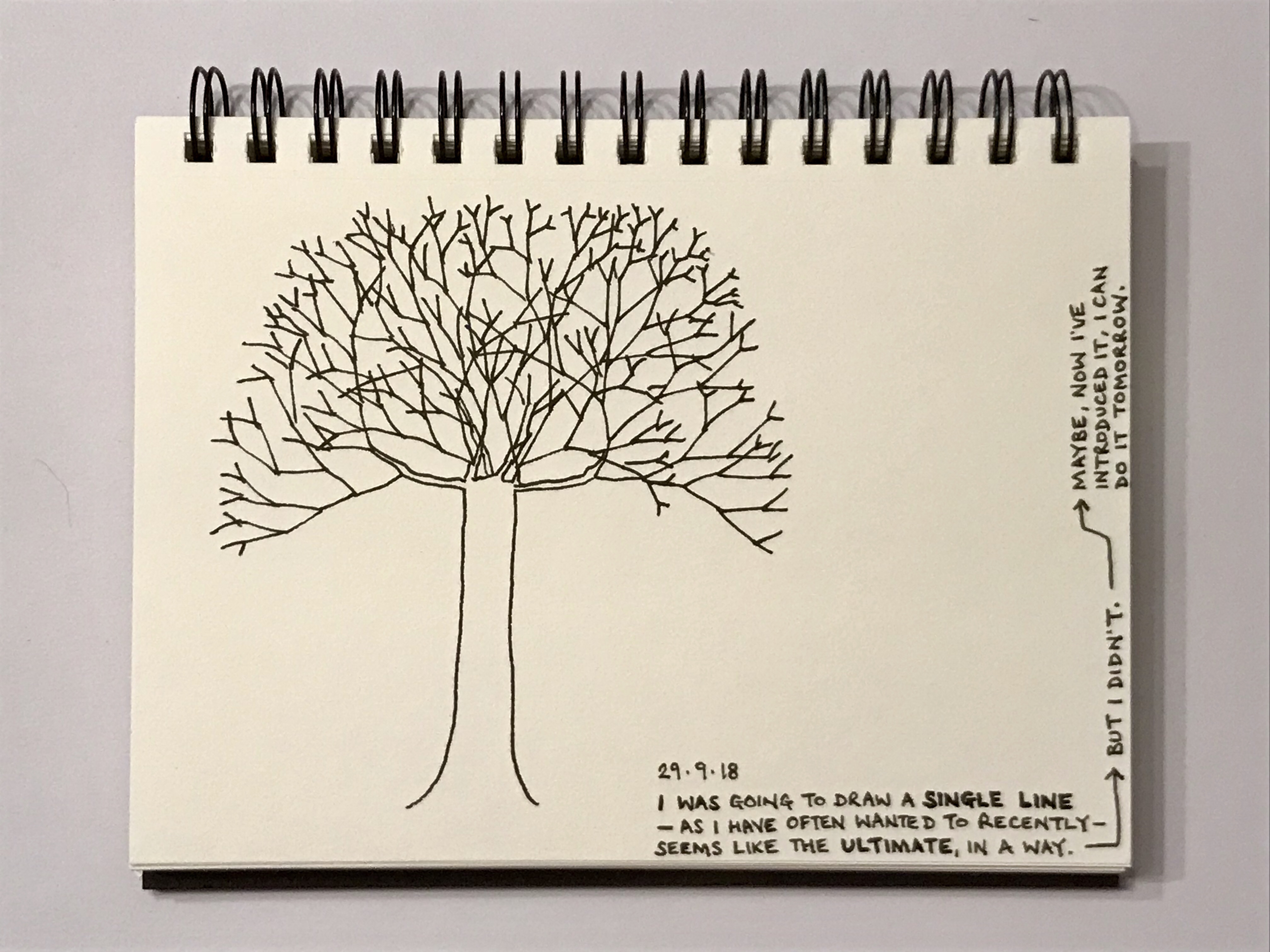
Then the next day, 30 September, I had a great feeling of anticipation about just drawing a single line, and felt very happy doing it.
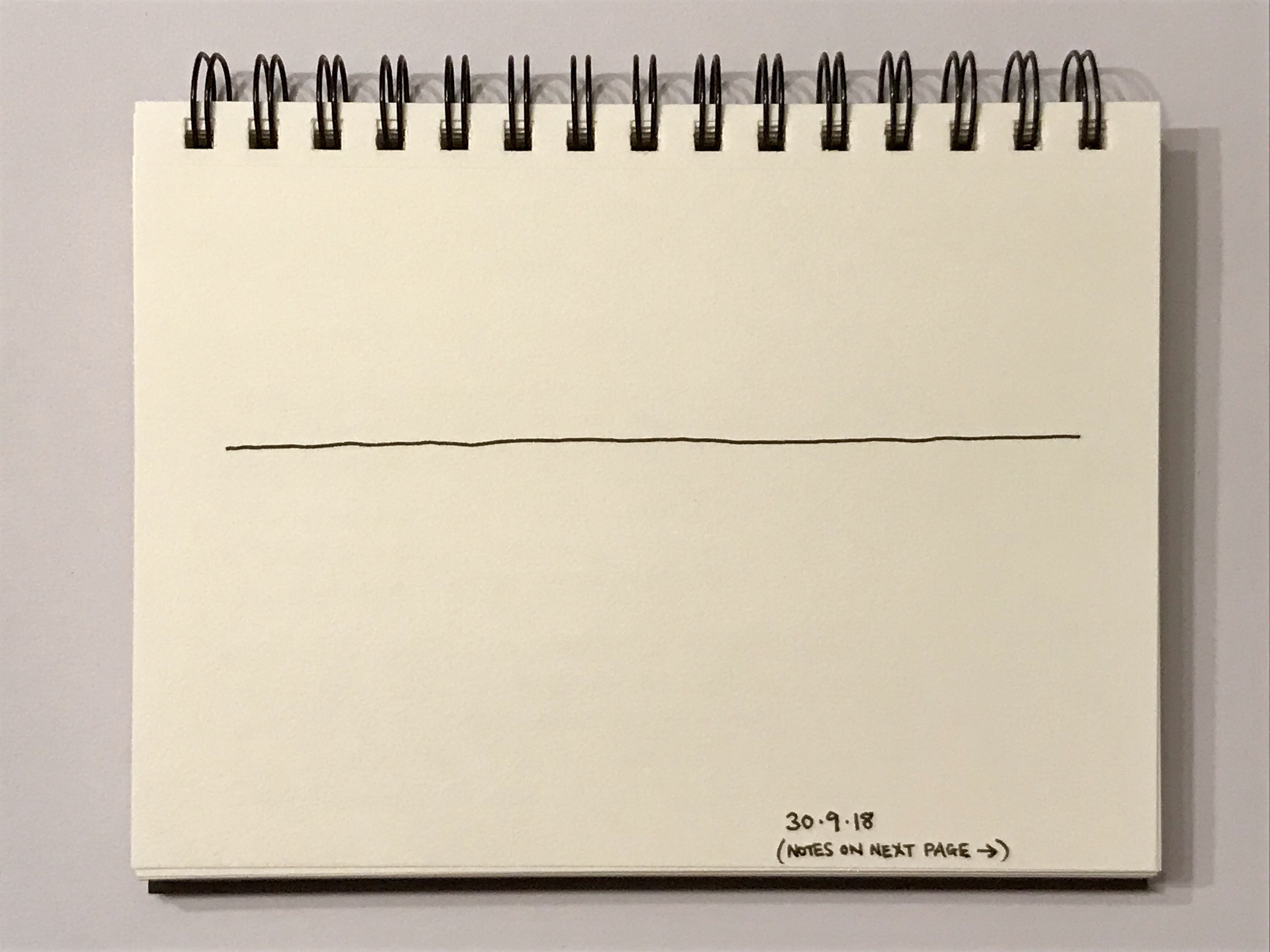
[That’s the page with the line, obviously. But then I also, unusually, felt compelled to write some pages of notes:]
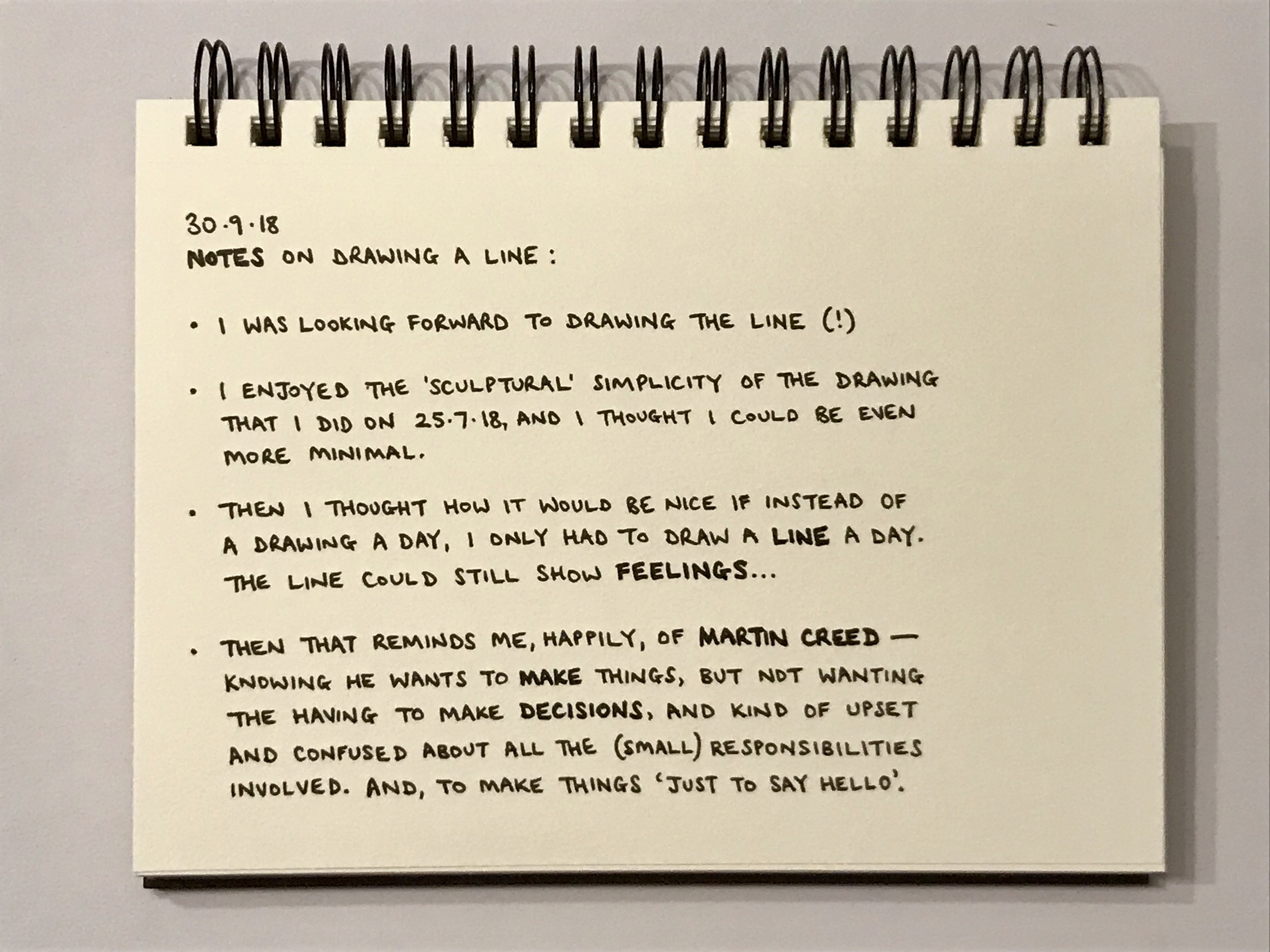
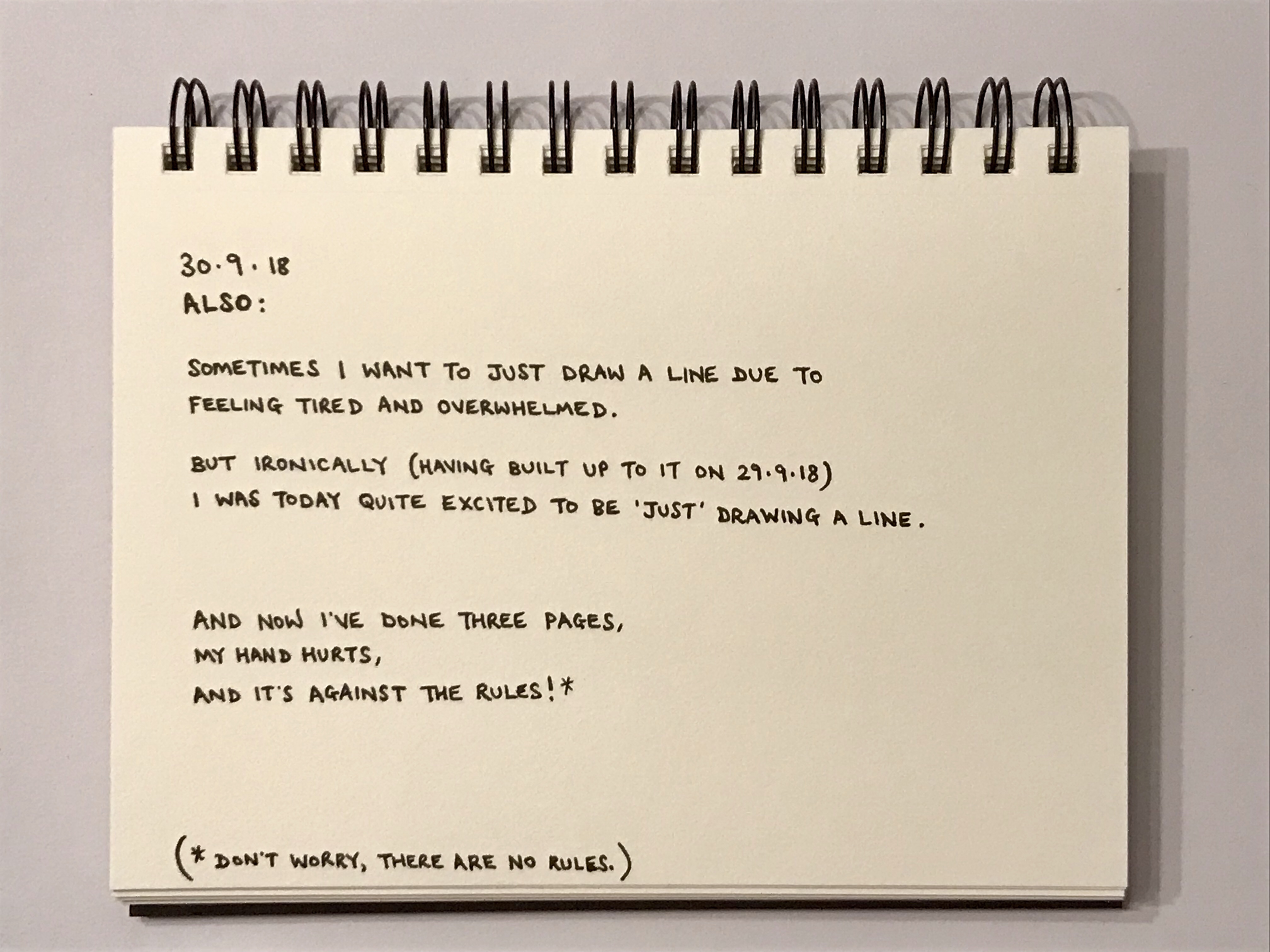
Quite soon after that I was reading about experimental music, and was led somehow to the work of Laurence Crane, an unassuming composer from England who makes gentle, sparse works with very few elements. In an essay about Crane’s work, fellow composer Michael Pisaro writes:
This is not minimalism. It does not take justification in “less is more” or “only what is necessary”. It takes us beyond those points: it is less than necessary. It says, basically, nothing is necessary. And perhaps, also, “let’s be happy with this.”
This kind of simplicity, done not primarily as an academic exercise in minimalism but because it is genuinely pleasing, seemed really nice. It does raise philosophical ideas about space and silence, and having less of things, but is not overwhelmed by them.
After this, and some time later, I stumbled across the work of the Wandelweiser collective, a whole little world of people making quiet, sparse music which draws you in. (My excitement at just drawing one single straight line in my drawing project – a surprisingly exhilarating feeling about something quite nothingy – seems related to the thrill felt in Wandelweiser concerts, where audiences are highly attentive to very faint sounds and delicate silences).
Wandelweiser began as a group of like-minded individuals in the 1990s and is now a broad, loose, international collective, not widely known, but too numerous for them to all meet up at once. The members of Wandelweiser began with a mutual fascination with John Cage, who famously demonstrated the value of silence in his work 4’33”, in which a performer sits at their instrument for four minutes and 33 seconds, but doesn’t play it. That piece is perhaps commonly seen as an arty ‘nothing’, or a philosophical gimmick, a piece of music with nothing in it as some kind of pretentious joke. But Cage meant it seriously, as a piece that would actually have a lot in it, if you paid attention to the ambient and incidental sounds in the environment. So space and silence can be things that a piece is made up of, just as music and other sounds can be things in the work. Jürg Frey, one of the best-known Wandelweiser composers, describes silence as ‘another kind of material’. He explains: ‘It is similar to a square in a town or city. The square may be empty, but it is defined by the buildings around it and the buildings are defined by it. Silence becomes part of the form.’
Eva-Maria Houben, one of the longest-established members, explains her approach:
As composer I want to create situations which may open a wide space of possibilities. Listening I want to find a location where nearly nothing is fixed, where nearly everything is possible… Between appearance and disappearance I find as a listener the possibility to create by myself… I am invited to fall into life.
Most kinds of music – and other kinds of creativity – aspire to basically be the thing that you are attending to, but this kind of music creates space where you might be attentive but there’s not a lot of prepared content, so elements of yourself and your environment are more invited to become a part of the experience.
Most of the composers I’ve mentioned here don’t want to be identified as minimalists, as such, perhaps because the frame of ‘minimalism’ doesn’t highlight the right things. ‘Minimalism’ might seem to emphasize the lack of material, whereas all of these creators are keenly interested in what is there – in the small moments, or atmospheric sounds – not in what isn’t.
The value of less
Marc Botha, in A Theory of Minimalism, writes that minimalism ‘intensifies and clarifies access to the real’ (2017, p. xiv). By stripping things down to the ‘least possible and the least necessary’ we reveal what is really important. Botha suggests that minimalism should not just be thought of as a mid-twentieth century movement in Western art, but as an idea which is global and which recurs across history. Sometimes it goes away, but then it comes back, to remind us of something important: ‘The radical force of minimalist aesthetics lies not in a single, historical event, but rather in its capacity to return, and in returning to turn aesthetics towards its most radical possibilities’ (p. xv). Minimalism occupies a ‘threshold position’, often between one thing and another – between vanishing and returning, between modernism and postmodernism, between silence and noise, or between nothing and things.
What I like about this is that Botha identifies the political edge to minimalism. This is valuable and interesting because minimalism is easily thought of as aloof and obscure, a theory more than a practice, aimed at arty insiders, and confusing because it seems like a joke but it isn’t actually funny. But as Botha explains:
Minimalism possesses a remarkable, and to many unexpected, capacity for reflecting and reflecting on complex political questions. Its prominence exposes important issues regarding the rapid commodification of art and the role of the artwork in public space; while on the level of structure, its transparency and emphasis on process clarify a great deal regarding the aesthetic coding of power and control, and the ethico-political aspects of aesthetic experience. (p. xv).
In other words, minimalism is about stripping away as much as we can, to see what is left, and that can reveal the positive spirit at the heart of a social movement, or can expose the fallacy or inequity at the heart of something fundamentally unjust. By reminding us of the beauty at the centre of things that have become complicated, minimalism can show the power of simple ideas. In a world where we may feel overwhelmed by the multiple contradictory accounts of reality, and with powerful political players creating webs of confusion around what may or may not be true, it’s obviously refreshing to have a model of stripped-down, pure and honest simplicity.
In The Longing for Less, Kyle Chayka embarks on a book-long quest to work out why people are drawn to minimalist art, music, and design. At one point, the author finds himself wandering among 100 near-identical metal boxes in a vast shed in Texas: this is the artwork 100 Untitled Works in Mill Aluminum by Donald Judd. The shimmering boxes are blank and meaningless, but also somehow fascinating and alive, and Chayka realizes that it is the absence of too much content that opens up possibilities:
Minimalism is a reminder of our ultimate autonomy, that the next second is an unforeseeable future in which we might do anything, or anything might happen to us. Feeling comfortable within that freedom is the challenge that minimalism poses. (2020, p. 101)
Again we get the sense that having not-too-much means – just as the Wandelweiser composers found – that a more minimal experience can be absolutely tingling with potential. If we leave space for a person to bring something of themselves into our work, it can allow for a stronger and more thoughtful connection.
KMRU
Joseph Kamaru, known as KMRU, grew up in Nairobi, Kenya, where he learned guitar and began to be a house and techno DJ. Soon, though, he became especially interested in field recordings, drones and ambient sound. During the Covid-19 pandemic, he moved to Berlin to study Sound Studies and Sonic Arts at the Universität der Künste, and received international acclaim for a flurry of albums released in 2020, including Jar, Peel and Opaquer. Unfolding gently, these works are made of apparently quite simple elements, atmospheres and environments as well as a limited number of electronic instruments and effects, sometimes at first seeming a bit like nothing, but drawing you into a layered world of emotion and contemplation. Kamaru’s grandfather, also called Joseph Kamaru, was a songwriter and activist in Kenya, famous for his timely songs addressing politics, corruption and sexual harassment. The younger Kamaru carries forward this independent-minded and prolific approach, but into more experimental territories. [You can watch my 2021 video interview with KMRU].
Marc Botha, writing about his observations of people’s encounters with minimalist sculpture, notes that these works provoke thought in part because people are not sure what to do with them – should I go up and touch this thing, or view it from far away? Do I need to spend time attending to it, or is it just there as part of the environment? Is it actually meant to be beautiful, or is it just an idea, and what is the appropriate way to respond to it? (Botha, 2017, pp. 27-29). Kamaru’s peaceful but unusual work, containing both ‘everyday’ and more constructed sounds, raises similar questions with no clear answers. He makes us think more closely about art partly because he sometimes makes things that could be mistaken for non-art.
Writing about Frank Stella’s series of 23 black paintings from 1958–60, Charles Altieri writes that ‘As these paintings break away from submission to external expectations, they seem to create fresh possibilities for how we might understand processes of choice, and hence orientations of desire’. Similarly, as Kamaru disregards the conventions of musical genres, he heightens our awareness that creativity can go in many directions. Reflecting on all the projects he released in 2020, Kamaru observed, ‘The more and more I create, the more I find my own space’. And although the work does not push an explicit political ‘message’, it does suggest that a complex world includes opportunities to build cathedrals of stillness and peace.
Attentive and present
Having expanded on some of the values of minimalist creativity, I now want to go back to the strange little universe of quiet music called Wandelweiser. Strange little universes are always interesting. One supportive point of light on the margins of this marginal universe is Simon Reynell, who runs the small independent record label Another Timbre, from the back room of his home in Sheffield, England.
In 2012 the label released ‘Wandelweiser und so weiter’ (‘Wandelweiser and so on’), a six-CD box set of exemplary Wandelweiser works and related things. [Yes, I did just say ‘CD’, and coming up soon is the word ‘booklet’. Some genres of music remain attached to certain physical formats, even as the world moves on]. In the accompanying booklet, Reynell cites the dictionary definition of ‘sound’ as a noun: ‘A narrow passage of water between the mainland and an island, or between two larger bodies of water’. He goes on to explain:
I used to envisage contemporary music as a complex river system, flowing in a myriad of channels that divide and reunite, sometimes combining with tributaries, sometimes disappearing underground, or flowing into stagnant backwaters. But with Wandelweiser I prefer the image of a sound: a body of water that can be more or less defined by what surrounds it, but which doesn’t move in a single, linear direction; which appears almost static, but is constantly shifting and reconfiguring itself. I especially like the idea of Wandelweiser as a ‘passage of water… between two larger bodies of water’, something without precisely defined boundaries that takes from and gives back to the expanses around it in a process of ongoing exchange.
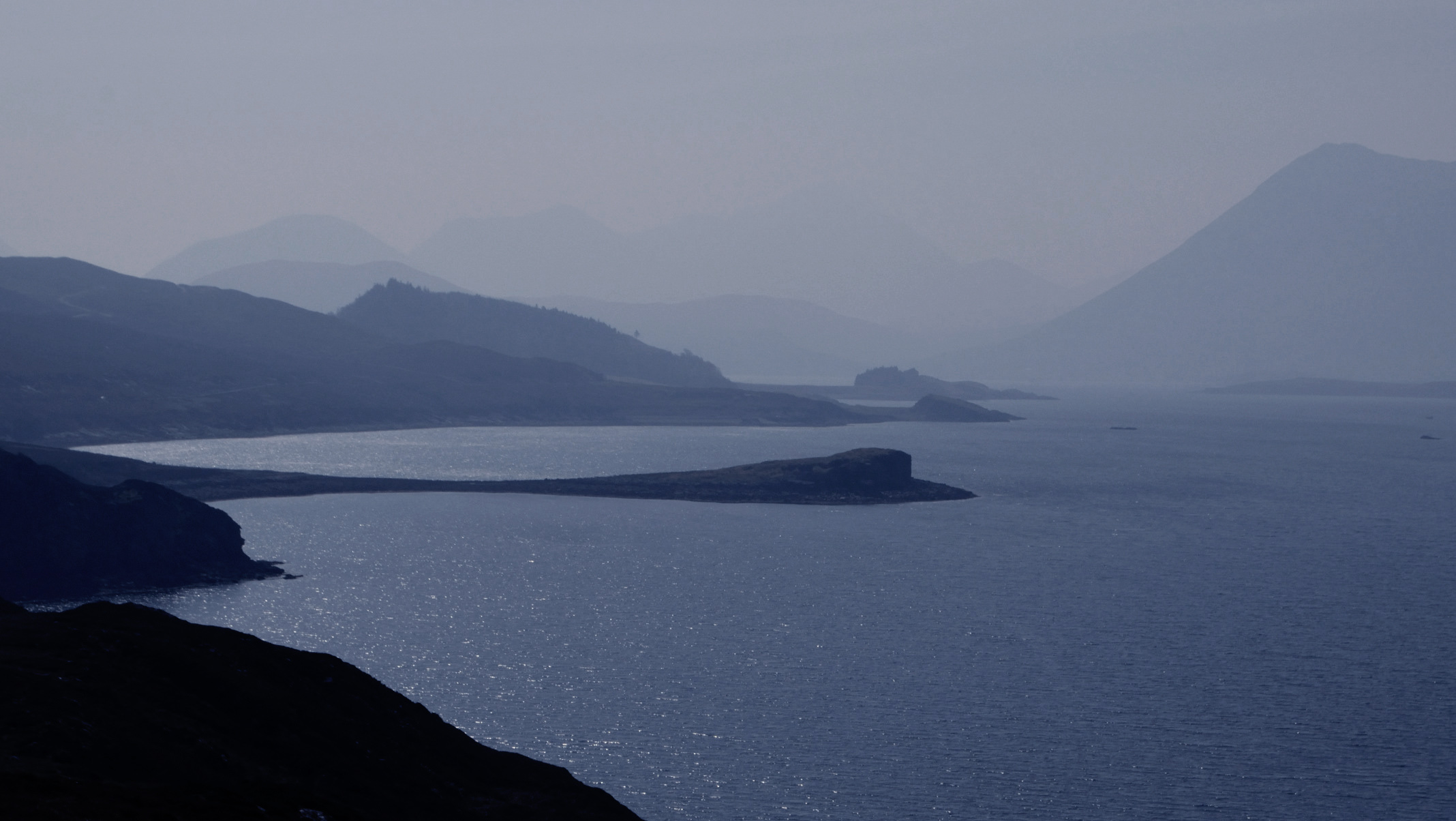
[So then I started searching for a nice image of a sound. This one is a photograph of the Sound of Raasay, off the coast of Scotland, by Andrew Tryon (licensed for reuse under a Creative Commons BY-SA 2.0 licence)].
Wandelweiser plucks edge-of-your-seat creative vibrancy from something that is sometimes barely there at all, and which is knitted into the other sounds of the world, somehow highlighting the golden qualities of both the made sounds and the already-there sounds. As Eva-Maria Houben explains, it’s not meant to be background music, or something that you would put on while reading a book. Being quiet or slow heightens the importance of listening – ‘being very present in the moment of listening’. If there is one thing that binds all the Wandelweiser composers, she says, it is that ‘they want to invite people to listen, to be here and to fully accept their existence in this moment’.
So doing less, in a creative project, and providing less material, can actually make it better. It allows more space for people to think, and to dream. As a creator, we feel responsible for entertaining or engaging people fully, and so we try to give maximum value by providing as much as possible. But as a person experiencing creative work, you probably don’t really want it to be ‘full on’ and maximally imposing. That’s good and exciting sometimes, or in particular shards. But not all the time. This is worth remembering.
[And the book goes on. If you liked this you might like to read the whole Creativity book!]

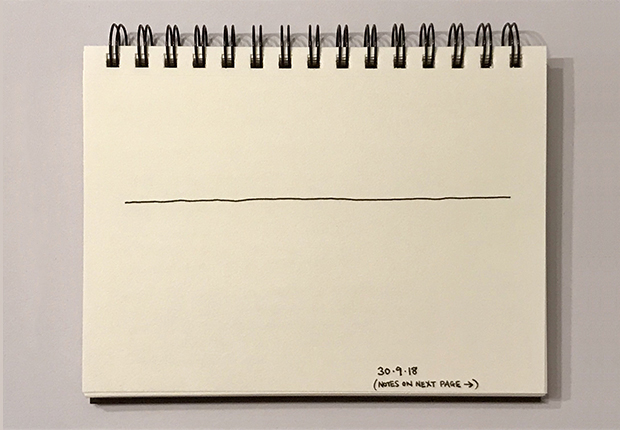






Thanks for the thoughts and insights, David. And I loved your line drawing